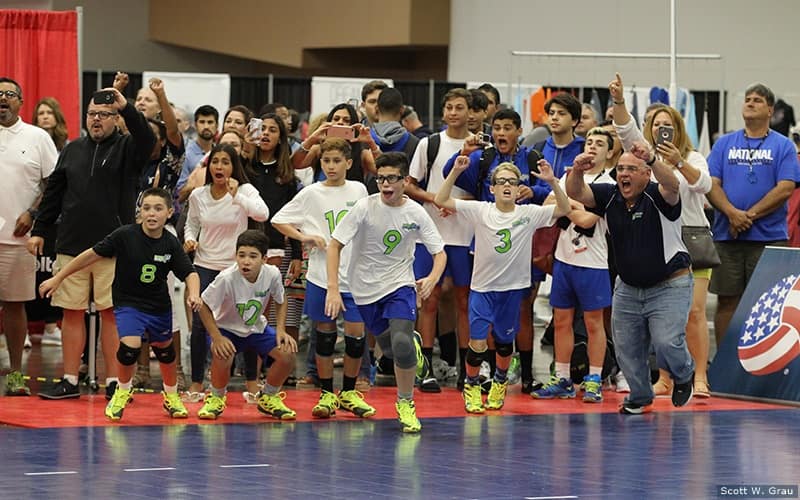
There is no better time to set the tone for good sportsmanship than in the minutes before first serve.
The challenge, however, is to make this activity more engaging than a half-hearted cheer. Making pregame acts of sportsmanship mandatory often diminishes genuine actions to something done just to appease parents and officials.
Pregame rituals should go beyond just looking good to the adults in the stands; they should actually mean something to the athletes. Americans long for youth sports to teach values like honesty, fair play and respect. Inspiring better behavior during the match begins by changing what is done before it.
Re-thinking the Pregame Greeting
While postgame handshake lines are a staple in volleyball, having the entire teams greet each other prior to the match is less common, but perhaps more effective. In matches played by the USA Volleyball U.S. Men's and Women's National Teams, for instance, opposing teams start with a greeting (and often a gift exchange) before the match; of course, there are also handshakes after.
A pregame greeting helps put names to faces and shows your athletes the other team is made up of kids just like them, rather than being some nameless ‘enemy.’ Even better is providing time for athletes from both teams to meet, chat and goof off together for a few minutes before adults issue any formal statements of sportsmanship.
An easy way to accomplish this might be to have the athletes stand in alternating fashion (as opposed to being divided by team) a few minutes before the national anthem plays and during any other pregame announcements.
As a coach, shaking hands and chatting with the officials and opposing coaches is also important for setting a good example for your team. Some coaches go so far as to have their players greet and thank officials and opposing coaches prior to the game. Not only does this encourage sportsmanship, it also helps younger athletes practice the components of a respectful greeting, including eye contact, a few polite words, and a firm handshake.
PA Announcer For A Day
Many (if not all) high school sports associations make a customary public address announcement about sportsmanship prior to a game, similar to this one from the Alabama High School Athletic Association:
“Good evening, (name of school) welcomes you to (name of field/stadium/gymnasium) for tonight’s game. We remind you that interscholastic events are an extension of the classroom, and that lessons are best learned when respect is shown to all. Please let your good sportsmanship show during the game.”
Unfortunately, announcements like these often fall on deaf ears amidst pregame excitement. One solution to get more people to pay attention is to allow one athlete be the honorary PA speaker, similar to how Major League Baseball games have a young fan announce the first batter in the lineup. People pay attention when kids take on a role usually held by adults, and this way they (and their teammates and opponents) might actually listen to the message being communicated.
Cross-Sport Sportsmanship
In high school, sportsmanship should not only be encouraged between opposing teams, but also between athletes from different sports within the same school. Pairing up teams that have parallel seasons and having them support each other with pregame activities (such as forming a tunnel) and then staying to act as a cheering section can help create a connection between athletes that might not otherwise interact or publicly support one another.
While getting an entire team to attend every home game is likely impossible due to other sports, school and life obligations, assigning a few team ‘ambassadors’ to each game can still provide some consistent representation. It could also be something done on a volunteer-basis, with a prize of some sort going to those who went out and supported their classmates the most.
Sportsmanship and Safety Huddles
Some youth sports teams and leagues do a pregame ‘safety huddle‘ with athletes, parents, coaches and officials. During this time, officials and coaches deliver a message about sportsmanship to the group, in addition to covering rules and injury protocol.
Similar to the PA announcement example above, this idea could be taken a step further and given more meaning if athletes were somehow involved in the meeting beyond just listening to adults talk at them.
Pre-Pre-Game Sportsmanship
Many admire sport’s ability to reveal a person’s true character and the ways they respond to adversity. But, the foundation of character isn’t only formed during pregame warm up or even in the locker room; it develops and grows at home, in school, and throughout everyday life.
Thinking of sportsmanship as something you can only teach in the context of sports is a quick way to deaden the message. Sportsmanship is learned inside and outside of sports. As a parent or coach, the way you treat other people and your attitude when things don’t go your way are ultimately going to have a bigger impact on your athletes than any pregame speech, no matter how friendly you are to officials and the opposing team’s coach.
In order for young athletes to keep sportsmanship top of mind during the action and excitement of a competition, the message needs to be reinforced frequently, consistently, and in a variety of ways. Pregame sportsmanship activities are a great way to make the message of sportsmanship more engaging and to set the right tone for the competition ahead.
About TrueSportTrueSport® inspires athletes, coaches, parents, and administrators to change the culture of youth sport through active engagement and thoughtful curriculum based on cornerstone lessons of sportsmanship, character-building, and clean and healthy performance, by creating leaders across communities through sport.

